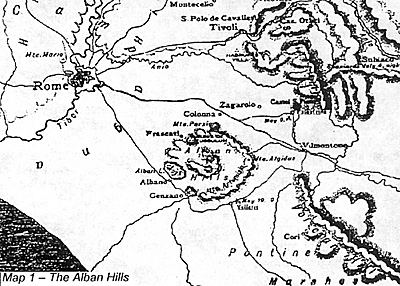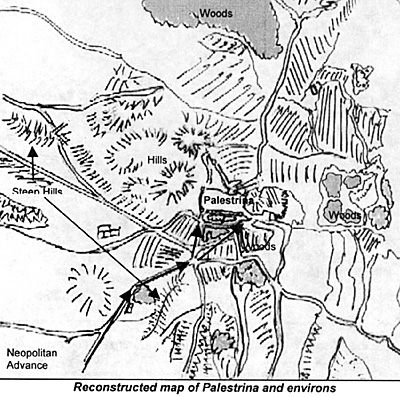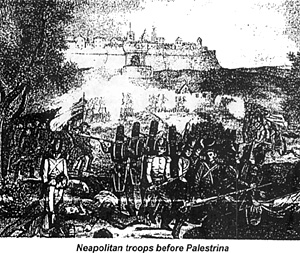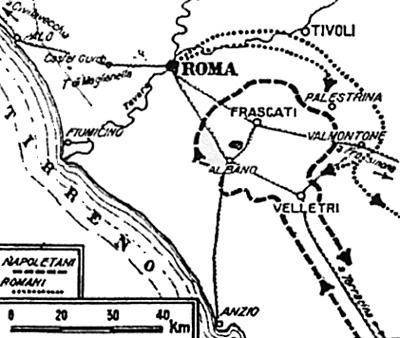Part One - Palestrina
While military glory for the Neapolitan's during the first war of Independence proved illusive to say the least, they did have the distinction of being involved in more theatres of the conflict than anybody else, including the Austrians. Elements of the Neapolitan army fought in Lombardy, in Venice, in Naples, in Sicily and in the Papal States. In these articles will consider their campaign in the Papal States against the Republic of Rome.
April 1849 saw the movement to free Italy in tatters, Piedmont was out of the war, and the Venito except for the city of Venice was in the hands of the Austrians, Naples was firmly back under Royal control while Sicily would soon be re-conquered. In the midst of this Rome stood defiant although she faced formidable odds. The Austrians were slowly moving south into Papal territory; a French expeditionary force was in Cittiaveccho soon to be joined by a small Spanish Army. And a Neapolitan army under King Ferdinand was moving up from the south.
 Map 1 – The Alban Hills
Map 1 – The Alban Hills
Jumbo Map of Alban Hills (slow 155K)
The reason for the presence of the Neapolitans is a little difficult to determine. Some sources suggest that the king had decided that the time was right for him to heed the Pope's calls to come to his aid, others that he did not want the moderate French to get into Rome and install a Papal government under their control while still others maintain that he sought to endear himself to the French who had suffered a reverse before Rome. Whatever the reason by early May he was established with an army of approximately 12,000 men in the Alban Hills just 25 kilometres from Rome (see map 1).
It is difficult to be precise regarding the composition of his army but it at least included the following units.
- 3 1/2 Battalions of the Guard including the Guard Jagers.
2 Regiments of Swiss Regulars
The 2nd Jager Regiment.
3 Cavalry Regiments
4 Batteries including one mountain battery.
These troops, who were stationed around Frascati and Albano, were reinforced during the course of the following weeks by various units.
The Roman Republic responded to this threat by dispatching a small force [1] under the command of Garibaldi. Upon establishing himself at Palestrina Garibaldi immediately sent out small detachments to harass the Neapolitan flank. This course of action inevitably resulted in several minor skirmishes, one of which took on a more serious aspect when a considerable force of Neapolitan's under General Winspeare met one of these parties near Monte Porzio and drove them back.
Minor victories, however, would never dislodge Garibaldi from his base at Palestrina and as long as he remained there he posed a threat to the Neapolitan supply lines back to Naples. Consequently, a larger Neapolitan force [2] under the command of General Lanza was ordered to march against Garibaldi at Palestrina and drive him back toward Rome.
Palestrina was a hill top town surrounded by ancient walls. The southern and lowest side the wall was punctuated by two gates (refer map), one to the southwest the other to the south east from which the roads to Rome and Valmontone proceeded respectively. When Lanza arrived before this southern wall at about 1pm he divided his troops into two columns [3] and launched them up the two roads which, although only about two km apart were hidden from each other by the rolling nature of the slope and by the brush which covered it.
Just what Lanza hoped to achieve is unclear as he made no attempt to reconnoitre the position and no scouts or skirmishers preceded either attack. Given this it is hardly surprising that both attacks met with disaster especially the right hand column, which was under the command of Novi.
 Reconstructed map of Palestrina and environs.
Reconstructed map of Palestrina and environs.
As Novi neared the town he found his way blocked by several companies [4] of the enemy who seemed to have appeared from nowhere. As soon as his men were within their range they began to advance while directing a steady fire on his tightly formed column. To make matters worse, further units could be seen issuing from the gate. He tried to deploy his leading platoons as skirmishers but the men, instead of spreading out as ordered, either bunched into small groups or ran to the rear.
The final straw came when a company of Manara's Bersagleri, having made their way along a ravine on the Neapolitans right, unleashed a fusillade on this flank causing further dismay among his men. This and the steady advance of the main body of Republicans proved too much for his men who, after firing only a few rounds, fled in panic to the rear. So ended the ill-fated attack on the Valmontone gate.
While this disaster was unfolding General Lanza advanced with the remainder of his command up the road toward the Roman gate. Here the Romans appear to have remained inside the city walls, which allowed Lanza to occupy several houses, located just outside the gate. Unfortunately any further progress was rendered unlikely as he failed to deploy his guns due, he claimed, to the accurate fire of the defenders.
 Neapolitan troops before Palestrina.
Neapolitan troops before Palestrina.
Despite little chance of success the Neapolitan's defended the houses tenaciously for several hours maintaining a constant exchange of fire with the Romans. They were only dislodged when a company of Manara's Bersagleri and a company of Roman Legionaries charged the houses and ejected them at the point of the bayonet. Even then Lanza did not give up the fight, he ordered the cavalry to attack in the hope that the advancing Roman troops could be forced back into the city.
This proved fruitless and the cavalry ended up covering the retreat of the column, which was able to make its way back to the main Neapolitan position in the Albano Hills unmolested. The Neapolitan's reported the loss of 10 men killed and 25 wounded in these engagements although some sources put the figure at almost 100 [5]. As it is clear that a number of Neapolitan's were captured the latter figure seems more realistic.
So ended the first phase of the Neapolitan campaign against the Roman Republic. If is difficult to put the defeat into a good light. While it is true that Garibaldi did retire on Rome (due to the French rather than the Neapolitans) the performance of the Neapolitan troops was poor to say the least, especially when one considers the fact that the majority of them were supposed to be members of an elite unit. However their performance should be seen in light of several factors, which worked against their being good soldiers. They were generally poorly trained and led. They were especially deficient in the skills necessary for close quarters fighting [6] and their weapons were inferior being for the most part flintlocks.
Furthermore they saw themselves primarily as policeman whose principle purpose was to keep the peace and perhaps most importantly they were excessively superstitious. They had been told that Garibaldi was evil and they took it literally. They had come to see Garibaldi as the devil incarnate and sought to protect themselves with all manner of religious relics, amulets and Madonnas.
So convinced were the men in the power of these "trinkets" that some appear to have believed that these and not their weapons would drive Garibaldi away. While such factors do not diminish the failure of the Neapolitans they do put that failure into a different light. They also make the stubborn defence before the Roman gate more of an achievement than it would otherwise have been.
 The Neapolitan's were left unmolested for several days due, as mentioned earlier to Garibaldi's recall to Rome. However their peace was short lived for an improvement in the relations between the Roman Republic and the French expeditionary force saw the bulk of the Roman army dispatched to drive them out of Roman territory once and for all. Their retreat in the face of this army and the subsequent fight at Velletri will form the second part in this sad saga.
The Neapolitan's were left unmolested for several days due, as mentioned earlier to Garibaldi's recall to Rome. However their peace was short lived for an improvement in the relations between the Roman Republic and the French expeditionary force saw the bulk of the Roman army dispatched to drive them out of Roman territory once and for all. Their retreat in the face of this army and the subsequent fight at Velletri will form the second part in this sad saga.
Endnotes
[1] The Roman forces consisted of Garibaldi's Legion, Marana's Bersagleri. The "Finanzieri", The Academic Legion, two companies of the National Guard and some volunteer units.
[2] Two regiments of the Royal Guard, four squadrons of cavalry and at least one battery, probably of mountain guns.
[3] The exact composition of each column is unclear although no guns appear to have been with Novi' s column.
[4] Apparently four companies, two from Garibaldi's Legion, the 4th company of Marana's Bersagleri and one of national guards.
[5] The losses of the Roman troops were 12 dead and 20 wounded.
[6] Despite this they did close with the Roman troops as at least one of the Romans was wounded by a bayonet.
Back to Clash of Empires No. 7/8 Table of Contents
Back to Clash of Empires List of Issues
Back to Master Magazine List
© Copyright 2000 by Keith Frye
This article appears in MagWeb (Magazine Web) on the Internet World Wide Web.
Other military history articles and gaming articles are available at http://www.magweb.com